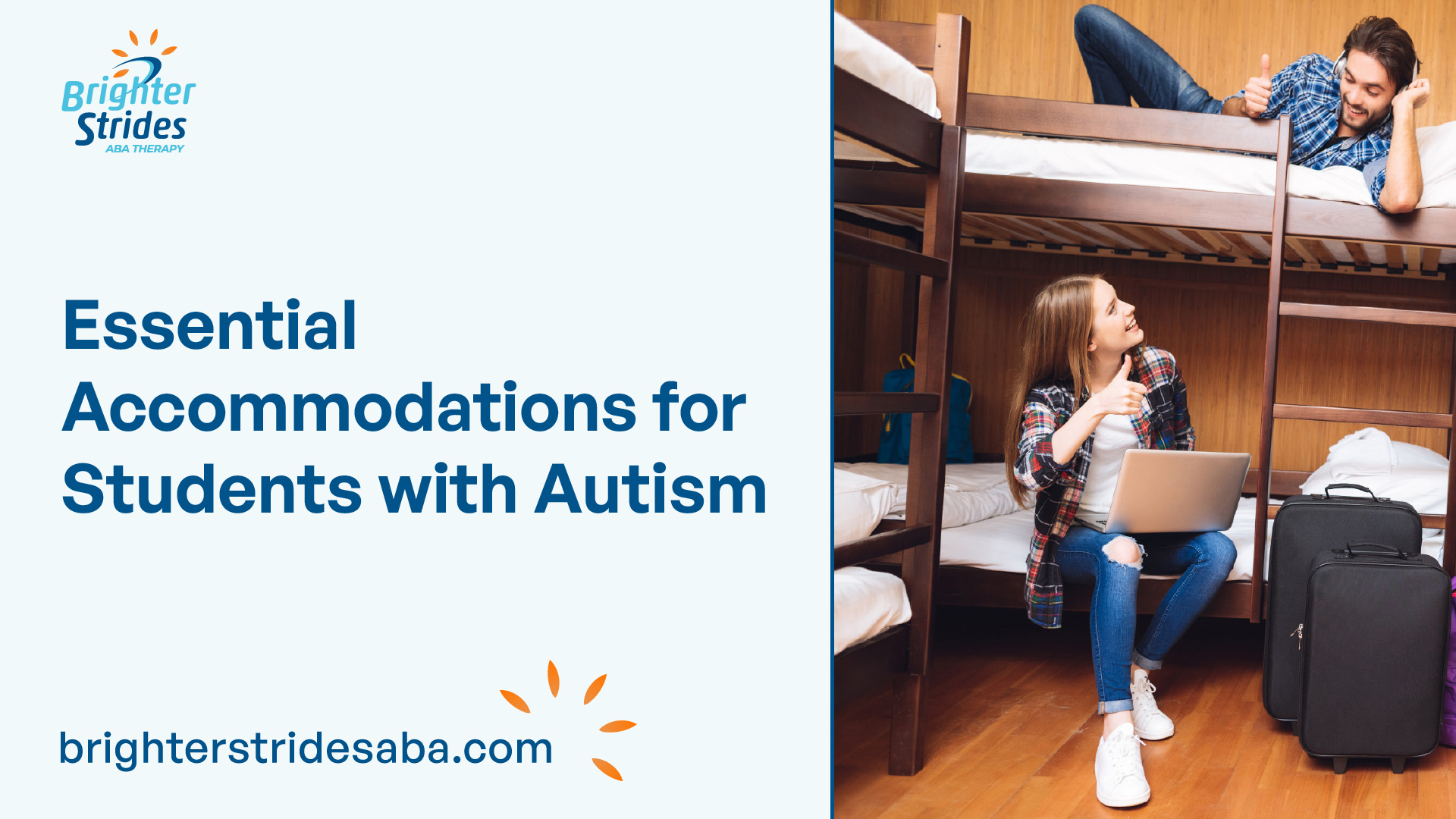Understanding Accommodations for Students
In order to create an inclusive learning environment for students with autism, it is crucial to understand the unique challenges they face and the accommodations that can support their success.

Challenges Faced by Students with Autism
Students with autism spectrum disorder (ASD) may encounter various challenges in the classroom. Some of these challenges, as outlined by the University of Washington, include:
- Difficulties with social interactions: Students with ASD may struggle with understanding social cues, initiating conversations, and maintaining appropriate eye contact, which can impact their ability to form relationships with peers and teachers.
- Sensory sensitivities: Many students with ASD experience heightened sensitivity to sensory stimuli, such as noise, bright lights, and certain textures. These sensitivities can lead to discomfort and distraction in the classroom.
- Changes in routines: Students with ASD often rely on predictable routines and may become anxious or overwhelmed when faced with unexpected changes. Transitions between activities can be particularly challenging.
- Fine motor skills and organization: Some students with ASD may have difficulty using pencils and paper for writing. They may also struggle with organizational skills, making it hard to keep track of assignments and materials.
Recognizing and understanding these challenges is essential for educators to provide appropriate accommodations and support to students with autism.
Federal Laws and Evidence-Based Practices
Federal laws mandate that educators use evidence-based practices when working with students with autism. The Every Student Succeeds Act (ESSA) and the Individuals with Disabilities Education Act (IDEA ’04) require educators to implement evidence-based strategies to improve outcomes for students with autism.
To support educators in implementing evidence-based practices, the National Professional Development Center (NPDC) on Autism Spectrum Disorder has identified 27 evidence-based practices. These practices are backed by research and have been shown to be effective in improving outcomes for students with autism.
By adhering to federal laws and utilizing evidence-based practices, educators can ensure that students with autism receive the accommodations and support they need to thrive in the classroom. This includes implementing targeted strategies, collecting baseline data, and including goals in individualized education programs (IEPs) or individualized family service plans (IFSPs).
Implementing Accommodations
To effectively support students with autism, implementing appropriate accommodations is essential. This section will explore the key steps involved in implementing accommodations, including defining the target behavior, collecting baseline data, and ensuring inclusion in individualized plans.
Defining Target Behavior
Before implementing accommodations, educators and practitioners should clearly define the target behavior they want to address in students with autism. This involves describing the behavior in an observable, measurable, and defined manner. By specifying the behavior, educators can focus on addressing specific needs and tailor accommodations accordingly.
For example, if a student with autism struggles with transitions between activities, the target behavior might be defined as “successfully transitioning from one activity to another without exhibiting disruptive or anxious behaviors.” This clear definition provides a framework for developing appropriate accommodations.
Collecting Baseline Data
Baseline data collection is an important step in implementing accommodations for students with autism. This involves gathering information on the student’s current behavior before introducing any new strategies or interventions. Baseline data serves as a reference point to measure the effectiveness of the accommodations and track progress over time.
Educators can collect baseline data by observing and recording the target behavior during specific time periods or activities. This data helps to establish a baseline level of the behavior and provides a basis for comparison when evaluating the impact of accommodations.
Inclusion in Individualized Plans
Once the target behavior has been defined and baseline data collected, it is crucial to include the accommodations in the student’s individualized education program (IEP) or individualized family service plan (IFSP). These plans outline the specialized supports and services required to meet the unique needs of students with autism.
In Maryland, accommodations for students with an IEP are documented in Section III of the IEP under Special Considerations and Accommodations, ensuring that the necessary support is provided for students to receive a free and appropriate public education. Similarly, students eligible for accommodations under Section 504 of the Rehabilitation Act should receive a 504 Accommodation Plan from their school. By documenting the accommodations in these individualized plans, it ensures that they are recognized and implemented consistently.
By following these steps, educators can effectively implement accommodations for students with autism, providing the necessary supports to foster their academic success and overall well-being. The process of defining the target behavior, collecting baseline data, and including accommodations in individualized plans ensures a systematic approach to meeting the unique needs of students with autism.
Factors Influencing Accommodations
When it comes to providing accommodations for students with autism, various factors play a role in determining the effectiveness and success of these accommodations. Two significant factors that influence the implementation of accommodations are teacher willingness and confidence, as well as institutional support and experience.
Teacher Willingness and Confidence
According to a study cited in ScienceDirect, teachers generally exhibit a high willingness to provide accommodations for students with autism. However, they may have limited confidence in their self-efficacy to effectively teach these students.
It is crucial for teachers to have a positive attitude and willingness to adapt their teaching methods and strategies to meet the diverse needs of students with autism. However, building confidence in providing accommodations requires ongoing professional development, training, and support. This can help teachers gain the necessary knowledge and skills to address the specific challenges faced by students with autism.
Institutional Support and Experience
Institutional support plays a vital role in influencing teachers’ self-efficacy and willingness to provide accommodations for students with autism. Teachers who receive higher levels of institutional support tend to have higher self-efficacy and are more willing to accommodate the needs of students with autism.
Moreover, teachers with experience teaching students with autism and being female tend to have higher self-efficacy in teaching students with autism. This suggests that experience and exposure to working with students on the autism spectrum can enhance teachers’ confidence in effectively meeting their needs.
To further support teachers, institutions should prioritize professional development programs that focus on autism education and provide resources, guidance, and opportunities for collaboration. By fostering a supportive environment, institutions can empower teachers to better understand and address the unique needs of students with autism.
By addressing the factors of teacher willingness, confidence, institutional support, and experience, educational institutions can create an environment where accommodations for students with autism are effectively implemented. It is crucial to recognize the importance of ongoing professional development and support for teachers to ensure the successful inclusion and education of students with autism.
Effective Strategies for Accommodations
When it comes to providing accommodations for students with autism, there are certain strategies that have been found to be effective in supporting their learning and development. In this section, we will explore two key strategies: online interventions for teachers and the impact of high willingness versus limited confidence.
Online Interventions for Teachers
Online interventions can play a significant role in increasing teachers’ knowledge and understanding of students with autism. Specifically, interventions that provide insights into the experiences of individuals with autism have shown promising results in enhancing teachers’ self-efficacy to teach students with autism [3].
By immersing teachers in a simulated online experience that reflects the challenges and strengths of individuals with autism, these interventions help to bridge the gap between teachers’ prior knowledge and the unique needs of their students. This increased understanding can lead to greater confidence in implementing accommodations and supporting the success of students with autism.
High Willingness vs. Limited Confidence
Research has shown that teachers often demonstrate a high willingness to provide accommodations for students with autism. However, they may also experience limited confidence in their self-efficacy to effectively teach these students. This disconnect between willingness and confidence highlights the importance of targeted support and professional development opportunities for teachers.
Receiving higher institutional support has been identified as a predictor of higher self-efficacy and willingness to provide accommodations for students with autism. This support can come in the form of resources, training programs, and collaboration with specialists or support staff. Additionally, teachers with experience teaching students with autism and being female have shown higher self-efficacy in teaching students with autism.
To bridge the gap between willingness and confidence, it is crucial for educational institutions to provide ongoing professional development opportunities that address the specific needs of students with autism. This can include training on evidence-based practices, strategies for creating inclusive classrooms, and collaboration with special education professionals. By empowering teachers with the knowledge and support they need, they can confidently implement accommodations and create a positive learning environment for students with autism.
Understanding effective strategies, such as online interventions for teachers and the importance of addressing willingness and confidence, can contribute to the successful implementation of accommodations for students with autism. By providing teachers with the necessary tools, resources, and support, we can create an inclusive educational experience that meets the unique needs of every student.
Helpful Accommodations for Students
When it comes to providing accommodations for students with autism, it is important to recognize that individual needs and determination play a crucial role. Accommodations are driven by the unique requirements of each student and are determined by the Individualized Education Program (IEP) team, with input from the student whenever possible.
Individual Needs and Determination
To ensure that accommodations are effective, it is essential to consider the specific needs of each student. This involves gathering information about the student’s strengths, challenges, and preferences. By understanding the individual characteristics of the student, educators and support teams can identify accommodations that will best support their learning and overall well-being.
It is also important to involve the student in the accommodation planning process. By seeking their input and listening to their perspectives, educators can gain valuable insights into their needs and preferences. This collaborative approach empowers the student, promotes self-advocacy, and helps create a supportive and inclusive learning environment.
Support Areas and Accommodations
Accommodations for students with autism can encompass various areas of support to address their specific challenges and optimize their learning experience. Some helpful accommodations may include:
- Sensory processing support: Providing a sensory-friendly environment, such as reducing noise levels or providing sensory breaks, can help students with autism manage sensory sensitivities.
- Behavioral interventions: Implementing strategies like visual schedules, social stories, and positive reinforcement systems can assist students in understanding expectations and managing behaviors effectively.
- Comprehension aids: Using visual aids, graphic organizers, and simplified language can aid in enhancing comprehension and promoting understanding of academic material.
- Reading and writing assistance: Offering additional time for reading and writing tasks, providing assistive technology tools, or utilizing alternative formats can support students with autism in their literacy skills.
- Executive functioning support: Teaching organizational and time management skills, breaking tasks into smaller steps, and providing visual reminders can help students with executive functioning difficulties stay organized and focused.
- Social interaction guidance: Implementing social skills instruction, peer mentoring, and structured social opportunities can assist students in developing and maintaining positive social interactions.
- Assistance with emotional regulation: Providing a calm and safe space, teaching coping strategies, and implementing mindfulness techniques can support students in managing their emotions and reducing anxiety.
These accommodations are just a few examples of the support that can be tailored to meet the specific needs of students with autism. The IEP team, which includes educators, parents, and relevant professionals, collaborates to determine the most effective accommodations for each student.
Differentiating accommodations from modifications is essential. While accommodations ensure students with autism have the necessary support to achieve the same level of mastery as their peers without special support, modifications involve changes to what a student is taught or the knowledge they are expected to demonstrate. Documenting accommodations in the IEP is crucial in ensuring that students receive the appropriate support for their education. Accommodations for students with an IEP in Maryland are documented in Section III of the IEP under Special Considerations and Accommodations.
Accommodations vs. Modifications
When it comes to supporting students with autism, it’s important to understand the distinction between accommodations and modifications. While both aim to meet the unique needs of students, they differ in their approach and goals.
Differentiating Changes
Modifications involve changes to what a student is taught or the knowledge they are expected to demonstrate. This can impact the ability of the student to master grade-level content. In contrast, accommodations are designed to ensure that students with disabilities achieve the same level of mastery as their peers without special support. Accommodations aim to minimize or eliminate the effects of the student’s disability and level the playing field, rather than changing the content itself.
For example, a modification might involve adjusting the curriculum or reducing the academic expectations for a student with autism. This could mean providing simplified assignments or altering the grading criteria. Modifications are typically made when the student requires a different set of learning objectives due to their disability.
On the other hand, accommodations focus on providing support and adjustments that enable students to access the same curriculum as their peers. Accommodations may include changes in timing, formatting, setting, scheduling, response, and presentation of tests and assignments. The goal is to ensure that students with autism can complete the same tasks and assessments as their non-disabled peers.
Documenting Accommodations in IEPs
Accommodations for students with autism are typically documented in an Individualized Education Program (IEP) or a 504 plan. In Maryland, for example, accommodations for students with an IEP are detailed in Section III of the IEP under Special Considerations and Accommodations. This section outlines the necessary support for the student to receive a free and appropriate public education.
When determining the appropriate accommodations, it is crucial to involve the student in the discussion. The student’s input and perspective are invaluable in identifying which accommodations would be most helpful for their learning and overall well-being. By taking the student’s preferences and needs into consideration, the accommodations can be tailored to address their specific challenges and promote their success in the classroom.
Differentiating accommodations from modifications is essential for ensuring that students with autism receive the appropriate support to thrive academically. By utilizing accommodations, educators can create an inclusive learning environment that allows students with autism to reach their full potential.

 We've just released an article!
Check out our blog!
We've just released an article!
Check out our blog!



